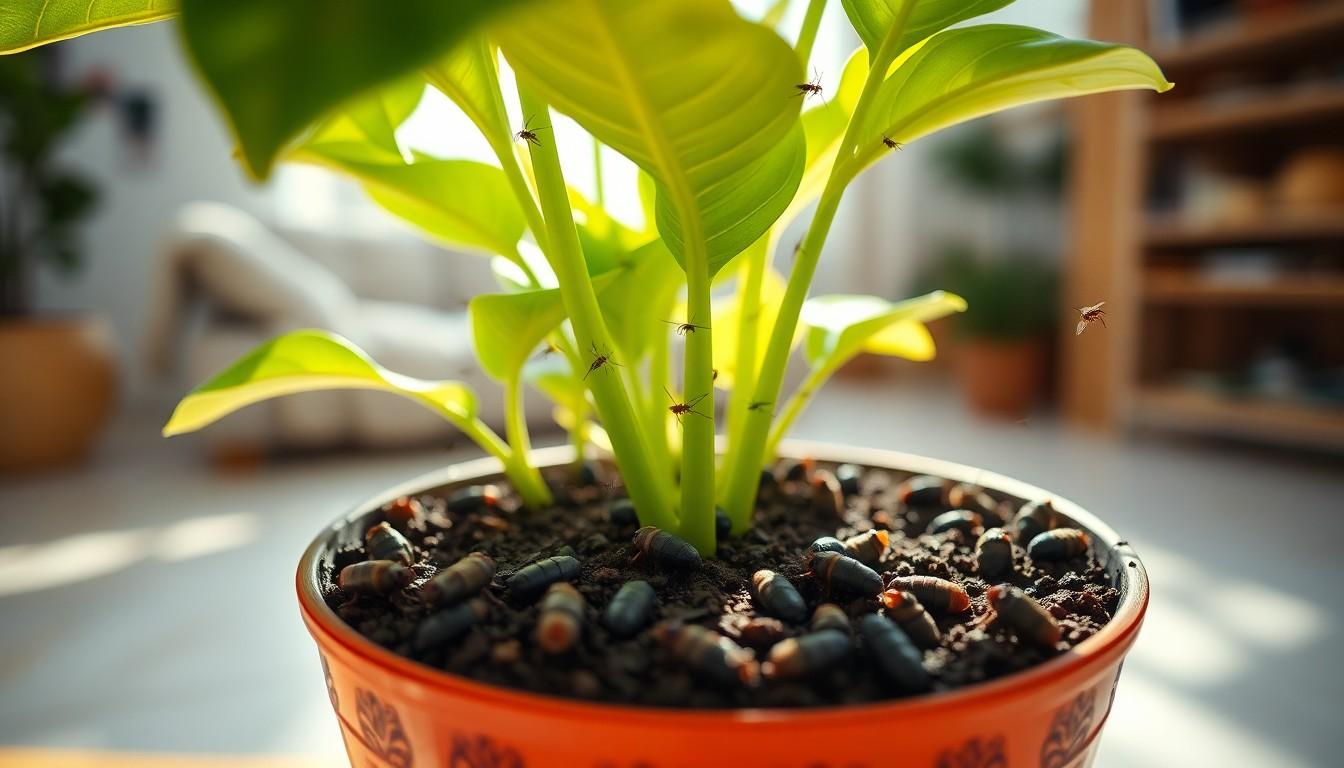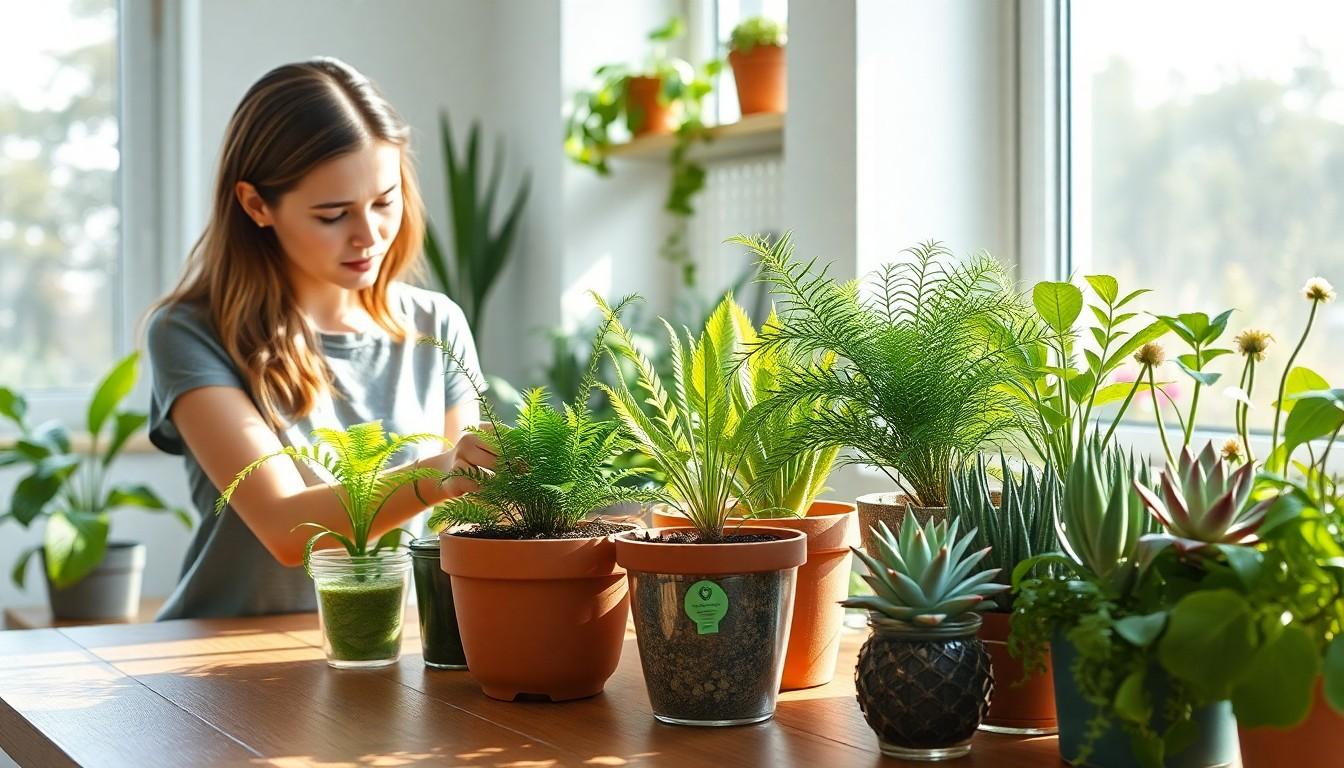Indoor plants bring life and vibrancy to any space, but nothing ruins that serene atmosphere quite like a swarm of gnats buzzing around. These tiny pests might seem harmless, but they can wreak havoc on your beloved greenery. If you’ve ever felt like you’re hosting an unwelcome party for these little intruders, you’re not alone.
Understanding Gnats in Indoor Plants
Gnats can create significant problems for indoor plants. Recognizing their types and understanding their life cycle helps in managing and eliminating these pests effectively.
Common Types of Gnats
Fungus gnats pose the most significant threat to indoor plants. They thrive in damp soil, laying eggs in it. Fruit flies also find their way indoors, drawn by decaying fruits and vegetables. Shore flies resemble fungus gnats but primarily feed on algae and decaying plant matter. Each type contributes to potential damage to indoor plants by breeding quickly in suitable environments.
Life Cycle of Gnats
Gnats undergo a four-stage life cycle: egg, larva, pupa, and adult. Eggs typically hatch within a week under favorable conditions. Larvae feed on organic material, affecting plant roots. Pupation occurs in the soil, where adult gnats emerge after several days. A new generation of gnats can appear in as little as two weeks, making timely intervention crucial for effective control.
Identifying Infestations

Identifying gnat infestations in indoor plants is crucial for effective management. Early detection can prevent severe damage to plants and minimize discomfort.
Signs of Gnat Infestation
Gnats often appear as small flying insects around plants, especially during watering or humidity. They typically swarm near the soil surface and light sources. Sticky traps can help catch adult gnats, providing visual confirmation of an infestation. Furthermore, inspecting the top layer of soil reveals dark, delicate larvae if the problem is more severe. Noticing a sudden increase in adult gnats suggests an underlying issue.
Impact on Indoor Plants
Gnat infestations can significantly damage indoor plants. Larvae feed on roots and organic matter, leading to weakened plants. Symptoms include yellowing leaves, stunted growth, and increased susceptibility to diseases. Adult gnats continue to breed, causing problems to worsen. A severe infestation may result in plant decline or death. Timely identification and action play a pivotal role in maintaining plant health.
Prevention Techniques
Preventing gnat infestations in indoor plants requires specific strategies, primarily focused on proper watering and soil management.
Proper Watering Practices
Watering practices significantly impact gnat populations. It’s crucial to allow the top inch of soil to dry out between waterings. This drying process disrupts gnat egg-laying and larval development. Overwatering promotes damp conditions ideal for gnats. Instead of daily watering, plants generally thrive with a schedule that considers their unique moisture needs. Implementing bottom watering methods can also minimize excess moisture on the soil surface.
Soil Management
Soil management plays a vital role in gnat prevention. Use sterilized or pre-packaged potting mixes as they typically contain fewer pests and pathogens. Adding a layer of sand or grit on top of the soil serves as a barrier, deterring gnats from laying eggs. Regularly inspect the soil for any signs of infestation. Replacing soil every season helps maintain a healthy environment and reduces the chance of gnat issues. Paying attention to these soil conditions supports overall plant health and prevents gnat populations from taking root.
Treatment Methods
Effective treatment methods address gnat infestations in indoor plants promptly to safeguard their health. Both natural remedies and chemical solutions offer viable approaches.
Natural Remedies
Diatomaceous earth serves as a deterrent for gnats. This fine powder, when sprinkled on the soil surface, damages the pests’ exoskeletons, ultimately leading to dehydration. Additionally, neem oil acts as a natural insecticide that disrupts the gnat life cycle when diluted and applied to the soil. Traps using apple cider vinegar attract and capture adult gnats efficiently. Another option involves using essential oils, such as peppermint or lavender, mixed with water and sprayed on plants to repel the pests. These methods prioritize organic solutions while fostering a healthy environment for indoor plants.
Chemical Solutions
Insecticidal soaps effectively manage gnat populations on indoor plants. These products target adult gnats without harming the plants or beneficial insects when applied correctly. Additionally, pyrethrin, a natural pesticide derived from chrysanthemum flowers, can eliminate adult gnats but needs careful monitoring to avoid plant damage. Granular insecticides, applied to the soil, provide extended protection against larvae. When using these chemicals, following instructions ensures proper application and reduces potential harm to the plants. Choosing appropriate products maximizes the effectiveness of pest control efforts.
Long-Term Maintenance
Maintaining indoor plants requires ongoing attention to prevent future gnat infestations. Consistent monitoring helps identify potential problems before they escalate.
Monitoring Infestation
Regular checks for signs of gnats remain essential. Sticky traps attract and capture adult gnats, offering insights into population levels. It proves beneficial to observe soil conditions too. Healthy soil remains less likely to harbor pests. Observing plants closely helps catch early signs like yellowing leaves or wilting. Methodically examining the environment ensures prompt detection, allowing for immediate action before infestations spread.
Care Tips for Healthy Plants
Healthy plants resist pest infestations better. Prioritize proper watering with a focus on allowing the top inch of soil to dry out. Adequate sunlight fosters strong growth, making plants more resilient. Feeding plants with balanced fertilizers promotes overall vitality. Using sterilized potting mixes creates an unfavorable environment for gnats. Additionally, consider rotating plants periodically to enhance air circulation. Regularly inspecting for signs of stress aids in maintaining plant health. Following these care tips establishes a solid foundation for both plant growth and protection against gnats.
Conclusion
Maintaining healthy indoor plants requires vigilance against gnats. By implementing effective prevention strategies and prompt treatment methods, it’s possible to keep these pests at bay. Regular monitoring and proper care can significantly reduce the likelihood of infestations. Utilizing natural remedies alongside chemical solutions ensures a balanced approach to pest management.
Creating an unfavorable environment for gnats not only protects plants but also promotes their overall health. With consistent attention to soil conditions and plant vitality, indoor gardening can remain a rewarding and beautiful experience free from the disruption caused by gnats.

